Ever bite into a crispy, golden-brown pocket only to be hit with a cheesy, meaty explosion of flavor? That, my friend, is the magic of toasted ravioli! Born in St. Louis but loved across the U.S., toasted ravioli has a backstory as rich as its filling. Whether you’ve seen it as an appetizer at a Midwest sports bar or tried recreating it at home, you’ll know it’s pure comfort food. In this guide, I’ll break down everything from its crunchy beginnings to foolproof homemade versions. Buckle up—your taste buds are about to get toasted!
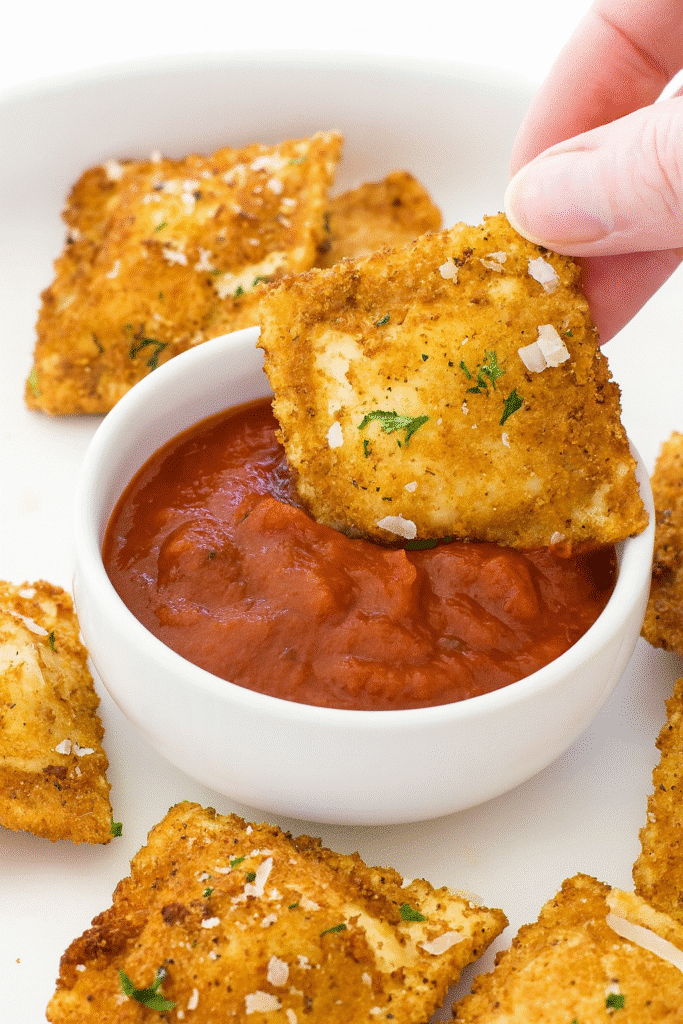
What Is Toasted Ravioli? (History + Origins)
Toasted ravioli isn’t your average pasta dish—it’s deep-fried, crispy on the outside, and stuffed with cheesy or meaty goodness on the inside. And despite the name, there’s no toaster involved. It’s crunchy comfort food with a side of surprising backstory.
The Accidental Invention in St. Louis
Legend has it that toasted ravioli was born out of a mistake—yep, one of those happy accidents. Back in the 1940s, a cook at Oldani’s (now known as Mama Campisi’s) on The Hill in St. Louis accidentally dropped ravioli into hot oil instead of boiling water. Rather than toss it out, someone gave it a try, added a bit of marinara, and realized they were onto something special. That single slip-up created one of the Midwest’s most iconic appetizers.
And trust me, it stuck. If you go to St. Louis today, toasted ravioli is basically a rite of passage. Every local restaurant and sports bar has their own version—and people will argue over which one’s best. It’s like barbecue in Texas. Everyone has an opinion.
Why Call It “Toasted”?
Okay, let’s clear this up. It’s fried. 100% fried. But “toasted” sounds… fancier? Maybe it tricks people into thinking it’s healthy? (Spoiler: it’s not.) I’ve always figured it’s one of those naming things that just stuck, like how buffalo wings don’t come from buffaloes. It rolls off the tongue better and gives it a little more flair on the menu.
That said, some places do try to actually toast it now. Like air fryer versions or oven-baked ones for a lighter twist. They’re not bad, but nothing—and I mean nothing—beats that golden crunch from the real deal oil fry. You hear that sizzle? That’s the sound of deliciousness.
A Midwest Obsession
Growing up outside the Midwest, I’d never heard of it. Toasted ravioli wasn’t a thing at my local pizza joint. But go to St. Louis or anywhere nearby, and it’s everywhere. It’s more than just food—it’s tradition. People serve it at weddings, tailgates, block parties. I even saw a birthday cake made entirely out of stacked toasted ravioli once. (No, I didn’t eat it. Regrets.)
And the best part? It’s ridiculously easy to love. Crunchy exterior, gooey middle, dipped in tangy marinara… What’s not to like? Once you try it, you’ll start wondering why this isn’t a global phenomenon. I mean, why isn’t it on every fast food menu by now?
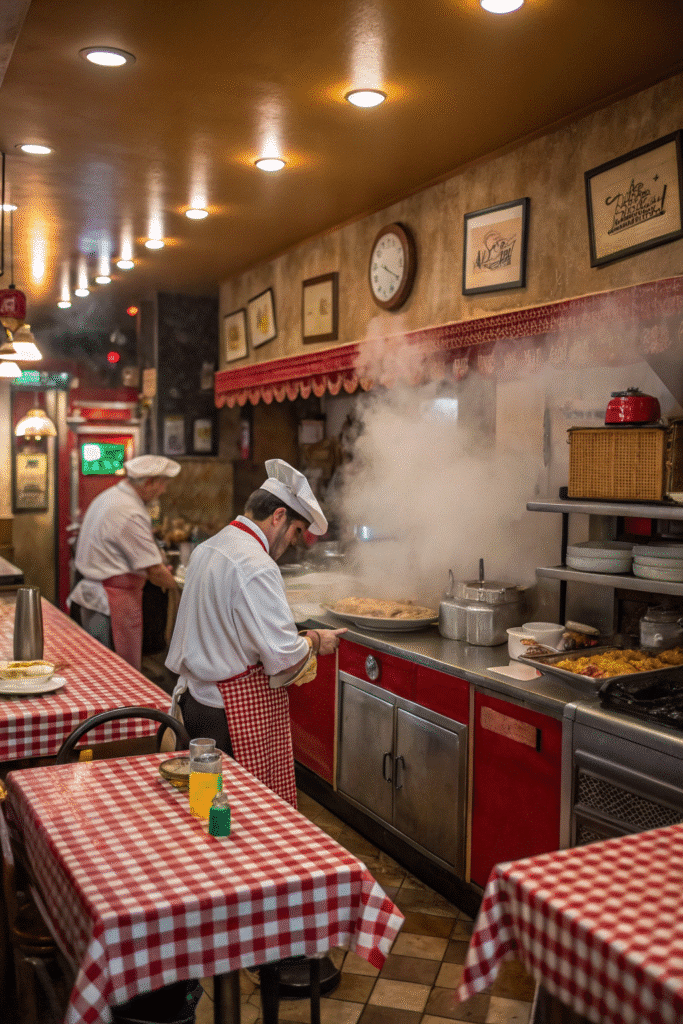
How to Make Toasted Ravioli at Home
Making toasted ravioli at home is dangerously easy—and I say “dangerously” because once you nail it, you’ll want to make it all the time. The first time I tried it, I figured it’d be some elaborate, messy process. But nope. With a few pantry staples and a pack of ravioli, I had golden, crispy goodness in under 30 minutes. It’s one of those recipes that makes you feel like a kitchen rockstar without breaking a sweat.
Start with the Right Ravioli
You don’t need to hand-make your own ravioli. Honestly, I’ve done both, and store-bought works great—especially when you’re craving something quick. Go for cheese-filled or meat-filled varieties, depending on your vibe. I love using beef for a more hearty, old-school flavor, but three-cheese ravioli with a hint of ricotta? Chef’s kiss.
Quick tip: Use frozen ravioli, but make sure they’re fully thawed before frying. If they’re still icy inside, you’re asking for an oil splatter disaster.
The Crispy Coating That Makes It
Here’s where the magic happens: the breading. I used to just toss them in breadcrumbs and call it a day—big mistake. You need a solid 3-step system: flour, egg wash, then seasoned breadcrumbs. I mix in a little grated Parmesan, garlic powder, and Italian seasoning with the breadcrumbs. It makes a huge difference. Trust me, plain breadcrumbs taste like cardboard in comparison.
Also, press the breadcrumbs into each ravioli a little. I used to just do a light dip, but then they came out patchy. You want that coating stuck on tight like a ravioli armor.
Frying vs. Air Fryer vs. Oven
Alright, let’s talk frying. Classic deep frying is king here. A neutral oil like canola or vegetable oil works great. Heat it to around 350°F—don’t guess, use a thermometer unless you like sad, soggy ravioli. I usually fry 4–5 at a time for about 2–3 minutes. Golden and bubbling = done.
Pan frying in a shallow skillet works if you don’t want to bust out the deep fryer. Just make sure you flip them halfway through.
Air fryer? Surprisingly solid. Brush or spray them with oil, 370°F for about 8–10 minutes, flip once. They get crispy, though the texture’s not quite the same. Still, way healthier if that’s your thing.
Oven-baked? Eh. It’s fine. Crunch is muted, but it works for big batches or if you’re cooking for a crowd who’s health-conscious.
Keep It Hot and Serve It Right
The minute those ravioli come out, sprinkle them with more Parmesan. Like, a snowstorm of it. And serve ’em immediately with warm marinara sauce. I sometimes heat the sauce with a splash of red wine or chili flakes just to give it that little restaurant vibe.
One time, I tried making a whole batch ahead for a party—huge mistake. They got soft sitting on the tray. If you’re doing that, keep them warm in the oven at 200°F and serve in small waves. That way they stay crispy and don’t go limp like sad noodles.
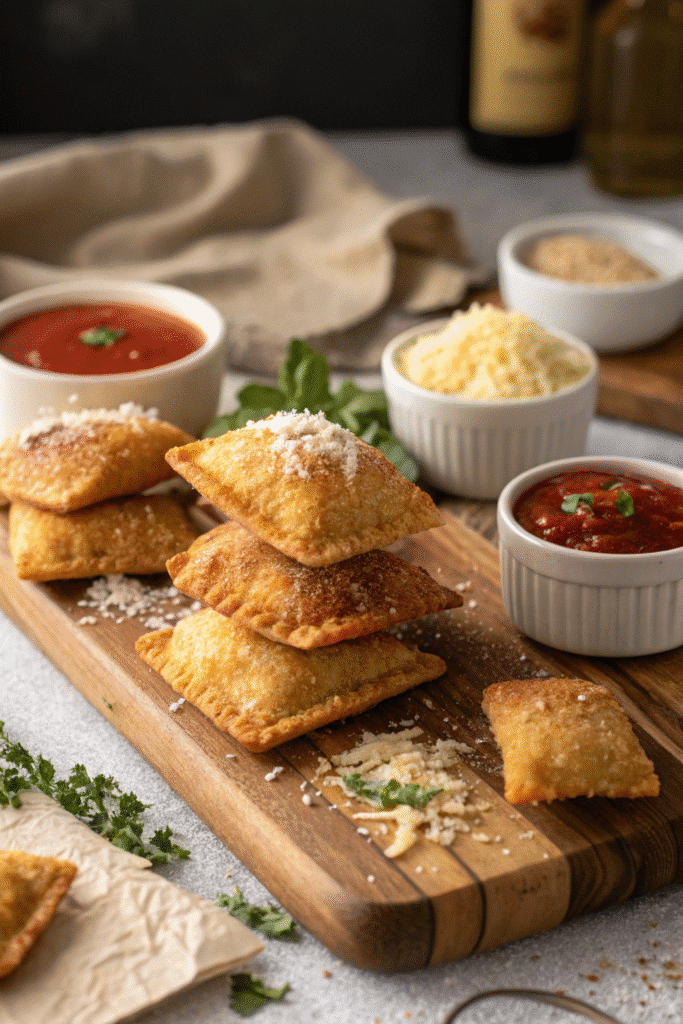
Best Fillings for Toasted Ravioli
You know what makes toasted ravioli even better than it already is? Custom fillings. Like, seriously—once I realized I wasn’t stuck with just cheese or beef, I went a little wild. I’ve experimented with everything from spicy buffalo chicken to caramelized onion and goat cheese (yep, it kinda slapped). You don’t need to be a chef to switch things up—just some flavor curiosity and a little courage.
The Classics Never Fail
Beef and cheese. The OG combo. There’s something super nostalgic about biting into a toasted ravioli filled with seasoned ground beef, a little ricotta, and a hint of Parmesan. That salty, meaty flavor just hits. Especially when paired with a bold marinara that’s got a little garlic bite.
And then there’s the all-cheese version. You’d think it’d be boring—nope. Creamy ricotta mixed with mozzarella and maybe a pinch of Romano cheese? It’s like biting into a molten cheese cloud with a crispy shell. I used to think it needed meat to be satisfying, but nope… cheese ravioli’s a star all on its own.
Getting Creative with Fillings
This is where things get fun—and occasionally weird. One of my biggest wins was buffalo chicken toasted ravioli. Shredded chicken, cream cheese, Frank’s RedHot, and a little ranch powder? Freakin’ addictive. Dip that in blue cheese dressing and you’ve got the appetizer that disappears first at any party.
Another surprise hit was spinach and ricotta. Sounds basic, right? But the contrast between the earthy spinach and the fried crunch was chef’s kiss. It works great with a garlic cream sauce or even a little pesto on the side.
Then there was the one time I tried a mushroom and caramelized onion filling. It was a mess to prep, I’ll be honest. I didn’t drain the mushrooms enough and the inside got watery. But the flavor? Unreal. Next time I’ll use less oil and maybe throw in some Gruyère.
Vegetarian & Vegan Options
I’ve been trying to eat less meat lately, so I’ve played with some vegan-friendly options too. A roasted butternut squash and sage filling was crazy good—kinda like fall wrapped in pasta. Chickpea and tahini? Didn’t love it. Tasted too… hummus-y. But sun-dried tomato and vegan mozzarella? Total win.
Pro tip if you’re going vegan: go for bold, punchy flavors. The fried shell does most of the heavy lifting texture-wise, so the inside needs to stand out. Also, avoid overly watery fillings. I made that mistake with zucchini once and ended up with sad, soggy bites.
What NOT to Use Inside
Not every idea’s a good one—ask me about the time I tried mac and cheese filling (spoiler: it exploded). You want something that holds its shape. Anything super saucy or loose just leaks out while frying and ruins the crisp.
I also learned the hard way that chunky fillings don’t work great unless you chop them finely. Big chunks of meat or veg can poke through the ravioli and make it split in the oil. No one wants a ravioli crime scene in their fryer.
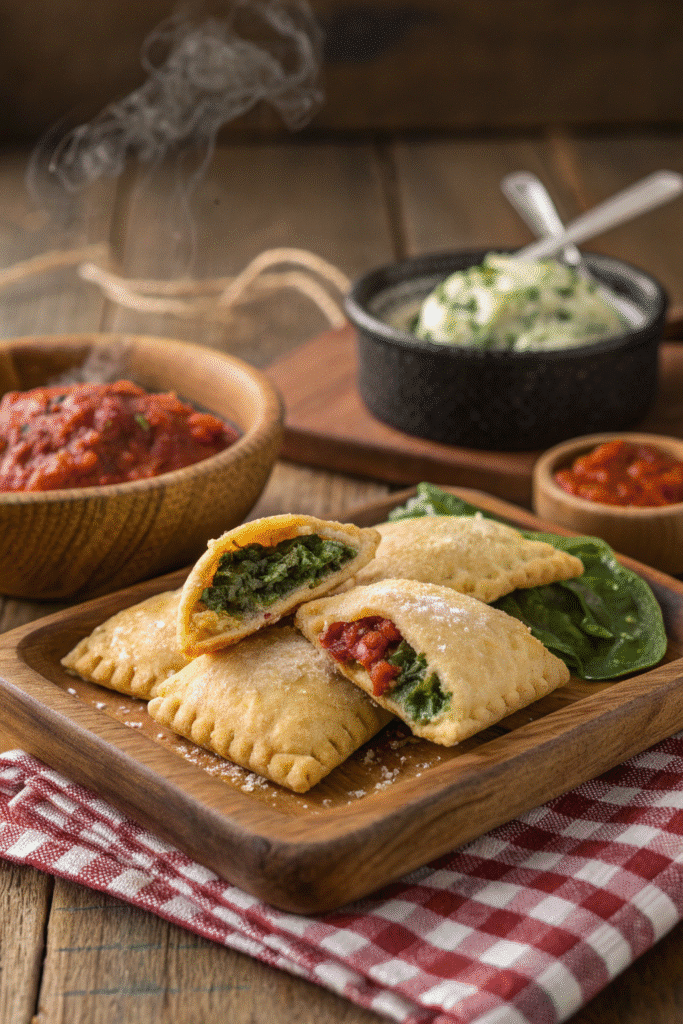
Perfect Dipping Sauces for Toasted Ravioli
If toasted ravioli had a best friend, it’d be dipping sauce. Seriously, the sauce is what ties it all together. I’ve had good ravioli turn great just because the dip was on point. And I’ve also had killer ravioli ruined by some cold, bland tomato sludge that tasted like it came from a can in 1997. Trust me—don’t sleep on the sauce.
Classic Marinara: The No-Brainer
You can’t go wrong with a solid marinara. I used to just grab a jar of store-bought stuff and heat it up. That worked okay… until I tried making it myself. Now I just sauté some garlic in olive oil, toss in crushed San Marzano tomatoes, a pinch of sugar, red pepper flakes, and let it simmer for like 20 minutes. Boom. Restaurant-level dip.
It’s tangy, slightly sweet, with just enough kick. And when you dunk a hot, crunchy ravioli into it and that sauce clings to all those little breadcrumb crevices? Absolute heaven.
If you’re feeling extra, stir in some fresh basil or a splash of red wine near the end. I started doing that on a whim once, and now it’s just how I roll.
Garlic Aioli: The Creamy Upgrade
Want to blow people’s minds? Serve your toasted ravioli with garlic aioli. I had it at a gastropub once and couldn’t believe how well it worked. The richness of the mayo-based dip with the crunch of the ravioli? Match made in snack food heaven.
You can make a cheater version by mixing mayo, minced garlic, lemon juice, and a little Dijon mustard. Let it chill for a bit before serving—it gets even better as it sits.
Pesto Ranch: Yep, It’s a Thing
I stumbled on this by accident. I had leftover pesto and ranch in the fridge, and was too lazy to pick just one. So I mixed them. That was the day I discovered pesto ranch. I put it on everything now—chicken tenders, sandwiches, but especially toasted ravioli.
The basil and garlic from the pesto mixed with the creamy tang of ranch is freakin’ addictive. Especially with veggie-filled ravioli. It’s like a garden party in your mouth, if the garden also served fried food.
Spicy Vodka Sauce: For the Bold
Sometimes I want something richer and more grown-up, so I go for spicy vodka sauce. You can use store-bought or whip it up with tomato paste, cream, vodka, red chili flakes, and a little butter. It’s silky, spicy, and feels a bit fancy.
It pairs best with cheese ravioli or mushroom-filled ones. Too heavy for meat fillings, IMO. But the creamy-spicy combo makes it perfect for date night appetizers—or when you’re just feeling like impressing yourself.
Pro Dipping Tips
Heat your sauce! Cold sauce on hot ravioli is a crime. I usually keep mine in a mini crockpot or just rewarm it in a saucepan right before serving.
Also, offer more than one sauce if you’re serving a crowd. I learned this at a family party where I put out marinara, pesto ranch, and garlic butter, and people went nuts. They started mixing them like little mad scientists. It was weirdly wholesome.
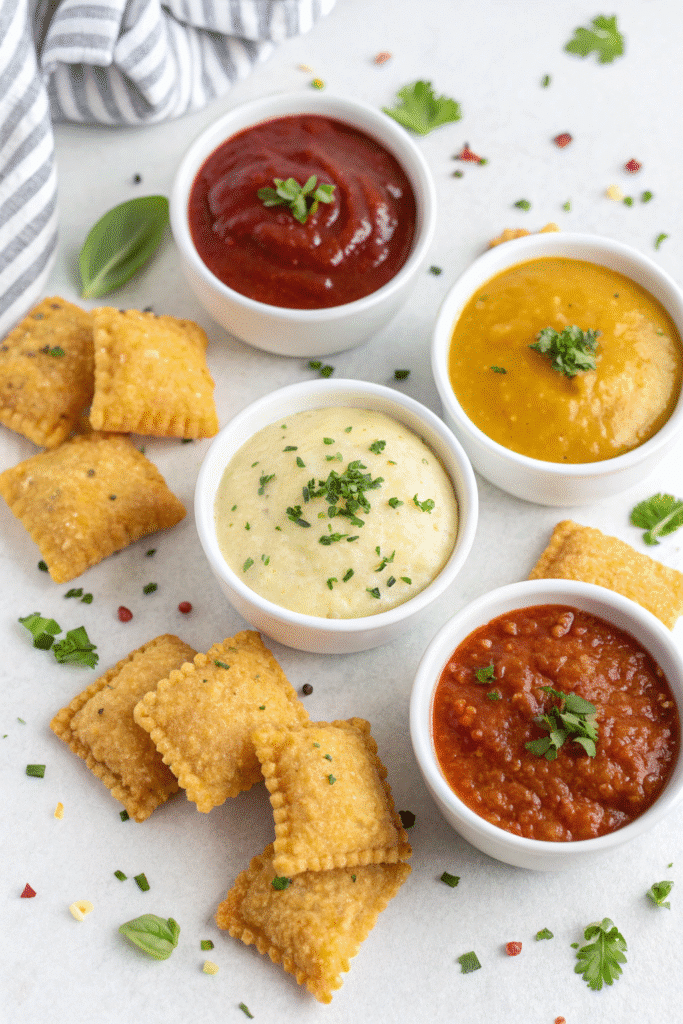
Tips for Serving and Storing Toasted Ravioli
Alright, so you made the perfect batch of toasted ravioli—crispy, golden, maybe even Instagram-worthy. Now comes the part nobody warns you about: keeping them that way. Because nothing’s sadder than biting into what was a crunchy ravioli, only to find it’s turned into a limp, soggy little pillow. I’ve been there. More than once.
Serve Immediately (Or As Close As Humanly Possible)
Toasted ravioli is one of those foods that’s best eaten right away. I’ve tried holding off and keeping them on the counter for “just a few minutes” while finishing other dishes. Bad idea. They get soft fast.
Now I serve them like pancakes—hot off the fryer or air fryer, straight to the table. If I’m feeding a group, I batch-fry and keep finished ones warm in the oven at around 200°F. Line a baking sheet with a wire rack so air circulates underneath. It makes a huge difference.
Add That Final Touch Before Serving
Right after they come out of the fryer? That’s your golden moment. Sprinkle them with a good dusting of Parmesan and maybe a pinch of sea salt. That added layer of salty cheese takes things to another level. Sometimes I’ll even throw on a few chopped herbs—parsley or basil—if I’m feeling extra.
And for serving, use a platter that retains heat. Cold plates zap their crispiness faster than you’d expect. Learned that one at a potluck the hard way.
Party Tips (Because They’ll Disappear Fast)
At parties, I use toothpicks so people can grab them without fumbling or double-dipping. I also put sauce in a few small bowls around the tray to prevent traffic jams at the marinara. People love options, and it keeps the flow going.
Also, if you’re taking them to go (like potlucks or tailgates), wrap them loosely in foil—not airtight—and re-crisp in an oven once you arrive. Microwaving? Don’t even think about it. You’ll regret it.
Storing Leftovers (If There Are Any)
On the rare occasion we don’t finish them all, I store the leftovers in an airtight container with a paper towel underneath to absorb any excess moisture. It helps, but let’s be real—they’re never as good the next day.
Still, they’re totally salvageable. Just reheat in an air fryer at 350°F for 4–5 minutes or bake them in the oven at 375°F until they crisp back up. Don’t re-fry them—you’ll end up overcooking the filling.
Freezing Toasted Ravioli
You can freeze toasted ravioli, but here’s the trick: freeze them after they’re breaded but before you fry. Lay them flat on a baking sheet until solid, then transfer to a freezer bag. That way, you can fry them fresh whenever the craving hits—no thawing needed.
If you’ve already fried them and want to freeze leftovers, wrap them individually in foil and freeze in a single layer. Reheat in an oven or air fryer to get them decently crisp again. Just don’t expect them to be quite as magical as Day One.
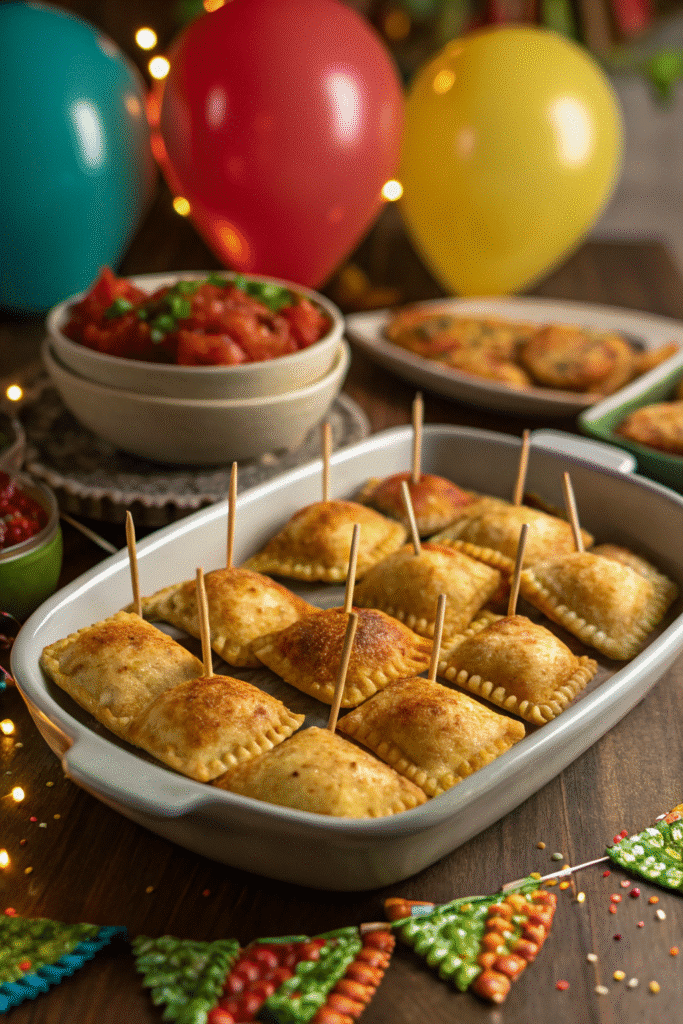
So there you have it—everything you need to know to conquer toasted ravioli like a pro. From its happy accident origin story in St. Louis to filling hacks, dipping sauce dreams, and crispy-cooked glory, it’s one of those foods that just works. It’s nostalgic, it’s crunchy, it’s cheesy (literally and emotionally, tbh), and it always hits the spot.
I’ve had toasted ravioli at family dinners, game nights, tailgates, and midnight fridge raids. No matter where or when, they’re a guaranteed crowd-pleaser. Whether you stick with the classic beef and marinara combo or go off-script with buffalo chicken and aioli, they never let you down.
And if you’ve never made them before? Please do. You’ll wonder why you waited so long. Just don’t be surprised when they vanish faster than you can fry ‘em.
If this guide gave you a craving—or better yet, results—go ahead and pin it on Pinterest! Share your creations, swap filling ideas, and spread the toasted ravioli love. The internet deserves to know.
Print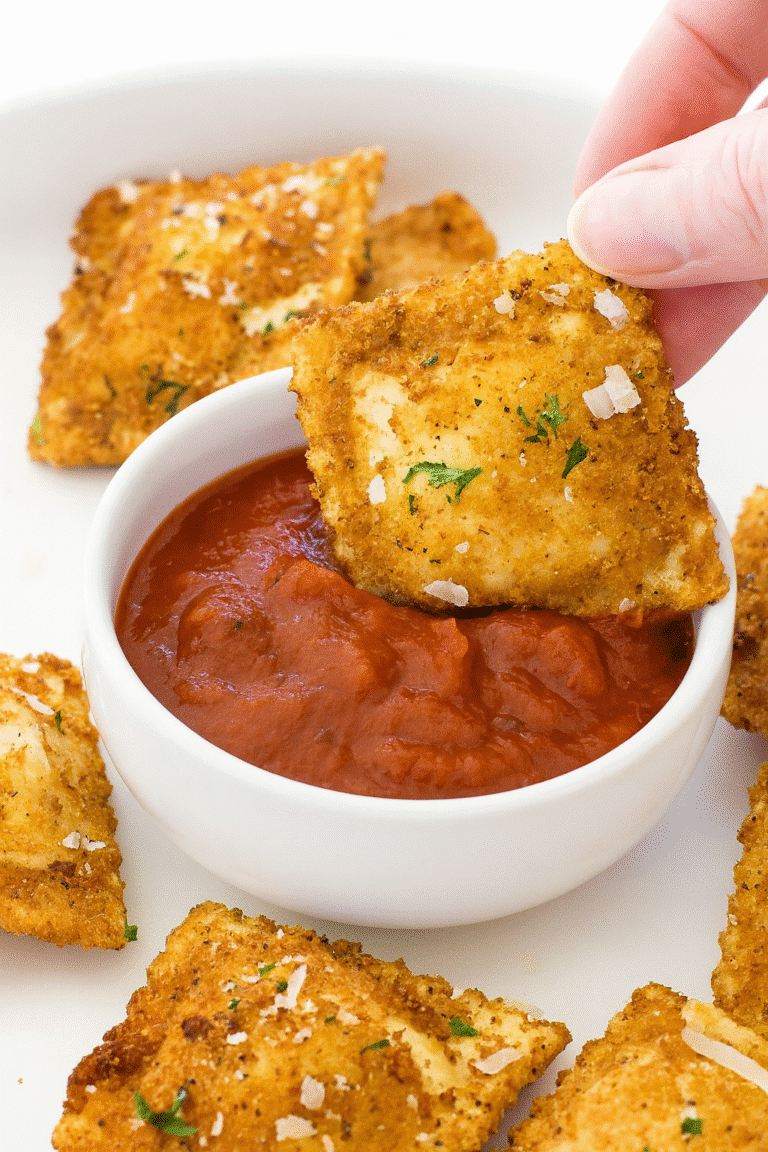
Toasted Ravioli Recipe
Crispy, golden-brown ravioli pockets filled with cheesy or meaty goodness, dipped in tangy marinara. A beloved Midwest comfort food born from a happy kitchen accident in St. Louis.
- Total Time: 30 minutes
- Yield: 4 servings 1x
Ingredients
- 1 package cheese or beef ravioli (store-bought, thawed if frozen)
- 1 cup all-purpose flour
- 2 large eggs, beaten
- 1 1/2 cups seasoned breadcrumbs
- 1/4 cup grated Parmesan cheese
- 1 tsp garlic powder
- 1 tsp Italian seasoning
- Canola or vegetable oil (for frying)
- Warm marinara sauce (for dipping)
Instructions
- Set up a breading station with three bowls: flour, beaten eggs, and seasoned breadcrumbs mixed with Parmesan, garlic powder, and Italian seasoning.
- Dredge each ravioli in flour, dip in egg, then coat in breadcrumb mixture, pressing firmly to adhere.
- Heat oil in a deep pan to 350°F (use a thermometer for accuracy).
- Fry ravioli in small batches for 2–3 minutes or until golden and crispy. Drain on paper towels.
- Immediately sprinkle fried ravioli with more Parmesan.
- Serve hot with warm marinara sauce for dipping.
Notes
To keep ravioli crispy for a party, hold in a 200°F oven on a wire rack-lined tray. Avoid microwaving leftovers—use an air fryer or oven for reheating. For a twist, try buffalo chicken or spinach ricotta fillings!
- Prep Time: 15 minutes
- Cook Time: 15 minutes
- Category: Appetizer
- Method: Fried
- Cuisine: American
Nutrition
- Serving Size: 4–6 ravioli
- Calories: 380
- Sugar: 2g
- Sodium: 720mg
- Fat: 22g
- Saturated Fat: 8g
- Unsaturated Fat: 12g
- Trans Fat: 0g
- Carbohydrates: 32g
- Fiber: 2g
- Protein: 10g
- Cholesterol: 55mg


